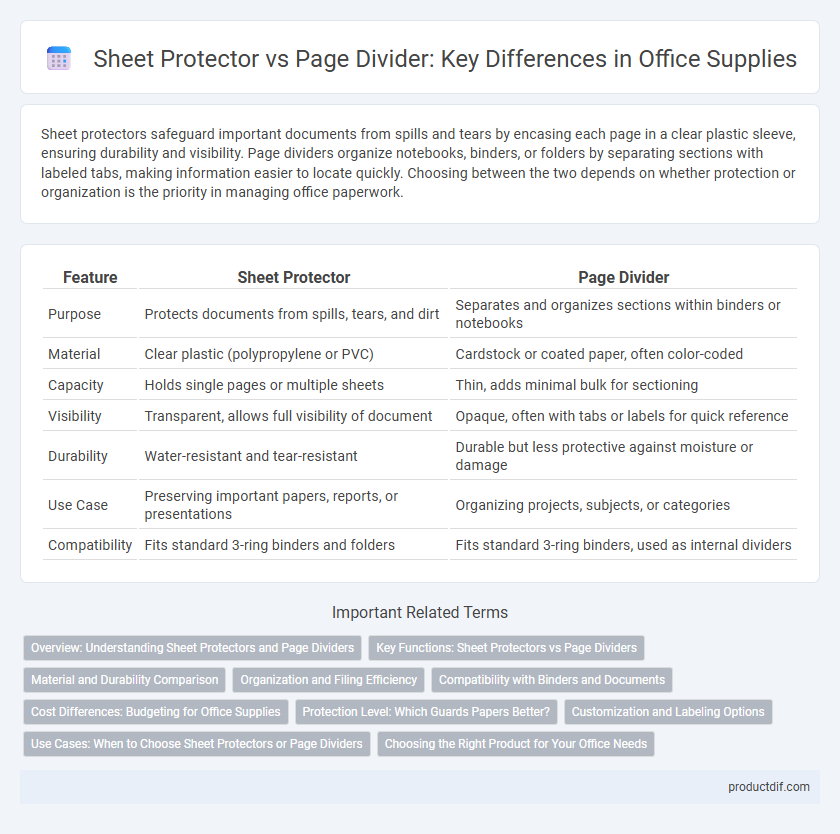Sheet protectors safeguard important documents from spills and tears by encasing each page in a clear plastic sleeve, ensuring durability and visibility. Page dividers organize notebooks, binders, or folders by separating sections with labeled tabs, making information easier to locate quickly. Choosing between the two depends on whether protection or organization is the priority in managing office paperwork.
Table of Comparison
| Feature | Sheet Protector | Page Divider |
|---|---|---|
| Purpose | Protects documents from spills, tears, and dirt | Separates and organizes sections within binders or notebooks |
| Material | Clear plastic (polypropylene or PVC) | Cardstock or coated paper, often color-coded |
| Capacity | Holds single pages or multiple sheets | Thin, adds minimal bulk for sectioning |
| Visibility | Transparent, allows full visibility of document | Opaque, often with tabs or labels for quick reference |
| Durability | Water-resistant and tear-resistant | Durable but less protective against moisture or damage |
| Use Case | Preserving important papers, reports, or presentations | Organizing projects, subjects, or categories |
| Compatibility | Fits standard 3-ring binders and folders | Fits standard 3-ring binders, used as internal dividers |
Overview: Understanding Sheet Protectors and Page Dividers
Sheet protectors are clear plastic sleeves designed to safeguard individual documents from spills, tears, and general wear while maintaining visibility. Page dividers are tabbed inserts used to organize and separate sections within binders or folders, enhancing document navigation and categorization. Both office supplies improve document management but serve distinct functions: protection versus organization.
Key Functions: Sheet Protectors vs Page Dividers
Sheet protectors provide durable, clear plastic sleeves that shield documents from dirt, moisture, and wear, ensuring long-term preservation and easy visibility. Page dividers, typically made from cardstock or plastic, organize sections within binders by separating pages with labeled tabs for quick referencing and improved navigation. While sheet protectors safeguard individual documents, page dividers enhance document organization by creating distinct categories or sections.
Material and Durability Comparison
Sheet protectors are typically crafted from transparent polypropylene or polyethylene, offering robust protection against spills, tears, and frequent handling, which enhances document longevity. Page dividers usually consist of thicker cardstock or plastic with reinforced tabs, providing durable separation and easy navigation within binders but less comprehensive document protection. The material composition of sheet protectors prioritizes water resistance and clarity, whereas page dividers focus on rigidity and tab durability for organizational efficiency.
Organization and Filing Efficiency
Sheet protectors safeguard documents from damage while maintaining clarity, making them ideal for preserving important papers in binders. Page dividers enhance filing efficiency by categorizing sections with labeled tabs, allowing quick access and streamlined organization. Combining both tools maximizes office organization by protecting documents and enabling efficient retrieval.
Compatibility with Binders and Documents
Sheet protectors offer clear, durable sleeves compatible with standard 3-ring binders, safeguarding documents from damage while maintaining visibility. Page dividers fit easily into binders with pre-punched holes or laminated tabs, organizing sections without adding bulk or altering the document's format. Choosing between the two depends on whether protection or organization is prioritized for binder-stored documents.
Cost Differences: Budgeting for Office Supplies
Sheet protectors generally cost more per unit than page dividers due to their durable plastic material designed to safeguard documents from damage. Page dividers are typically less expensive and serve the purpose of organizing sections within binders without providing protective coverage. Budgeting for office supplies requires balancing the higher investment in sheet protectors for document preservation against the economical advantage of page dividers for simple organization.
Protection Level: Which Guards Papers Better?
Sheet protectors offer superior protection by encasing each document in a clear, plastic sleeve that guards against spills, tears, and dirt. Page dividers provide organization but leave papers exposed and vulnerable to damage during handling or storage. For preserving important documents, sheet protectors deliver a higher level of physical safeguard compared to page dividers.
Customization and Labeling Options
Sheet protectors offer limited customization with clear, durable plastic sleeves designed to safeguard documents without altering their appearance, while page dividers provide extensive labeling options such as tab colors, sizes, and printable inserts for personalized organization. Customizable tabs on page dividers allow users to categorize sections effectively, enhancing document navigation. Sheet protectors primarily focus on preservation, whereas page dividers emphasize efficient sorting and labeling within binders.
Use Cases: When to Choose Sheet Protectors or Page Dividers
Sheet protectors are ideal for preserving important documents, preventing damage from spills, tears, and frequent handling, making them perfect for presentations, archival storage, and frequently referenced materials. Page dividers are best used for organizing notebooks, binders, and files by creating clear, easy-to-navigate sections for categories, subjects, or dates. Choose sheet protectors when document preservation is a priority, and page dividers when the goal is efficient sectional organization within binders or folders.
Choosing the Right Product for Your Office Needs
Selecting between sheet protectors and page dividers depends on document organization and protection priorities; sheet protectors offer durable, clear sleeves ideal for safeguarding important papers from wear, while page dividers facilitate quick navigation within binders by segmenting sections with labeled tabs. For frequent reference materials requiring preservation, polypropylene sheet protectors ensure longevity and moisture resistance. Conversely, color-coded or numbered page dividers enhance efficiency in filing systems by improving document accessibility and visual categorization.
Sheet Protector vs Page Divider Infographic

 productdif.com
productdif.com